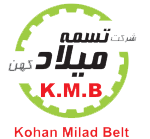Rubber timing belt
Rubber timing belts are usually made of rubber and plastic. The term “timing belt” usually refers to a rubber toothed belt. The advantages of timing belts are usually lower cost, reduced friction losses, less noise, and that belts traditionally do not require lubrication and are produced on both sides and on one side.
Rubber decomposes at higher temperatures and in contact with engine oil
The manufacturer’s specification timing belt may stretch at high revs, delaying the cam and thus the ignition. Stronger, aftermarket belts do not stretch and timing is maintained. When designing a timing belt, a wider belt increases its strength, but a narrower belt reduces weight and friction.
Types of rubber timing belt gears
In a general classification, rubber timing belts can be classified into three groups:
Round gear timing belts
Flat gear timing belts
Timing belts on both sides of the gear
The group means the first gear timing belts of different types and their main characteristic is the English letter M, but still you may come across other words and characteristics such as STD, S, HTD, RPP. S and STD means that the steps of this type of timing belts are trapezoidal.
Types of round gear timing belt and its use:
Round gear timing belt: 2M - 3M - 4.5M - 5M - 8M - 14M - 20M This family of round gear timing belt is called (HTD) and it is used in places where the machine works with high speed. will be
Flat gear timing belt. Flat gear timing belt pitch: MXL - XL - L - H - XH - XXH. This type of flat gear timing belt is used where the machine works with high power.
Timing belt on both sides of the gear. Timing belt on both sides of the gear: DXL - DL - DH - D5M - D8M - D14M. This type of timing belt is used in places where it is necessary to circulate a timing belt of several follies at the same time.
The round gear timing belt works like a chain and a gear wheel, and the ribs of the round gear timing belt create suitable friction with the grooves of the gear wheel and are used in tile and ceramic machinery, printing and packaging, oil and petrochemical, food, etc. It works. Round gear timing belts are useful in cars and industries.
Flat gear timing belt
The length of the flat rib timing belt cannot be changed, and the number of belt ribs is specified and made of fabric, but the width of these belts is cut according to the width of the corresponding foley. The gear shape of the flat gear timing belt is also different based on the existing standard codes and each gear type has different steps.
Industrial flat gear timing belt such as:
XL, L, H, XH, XXH, T5, T10, T20, AT5, AT10, AT20
This type of timing belts mentioned above have flat gears and are sometimes used with an anti-wear coating in the tile or printing and packaging industries.
Since the rubber and material used in the construction of the flat gear timing belt wear out over time due to the heat produced, the flat gear timing belt needs to be replaced periodically. This is the case with engines that have oil leaks and the possibility Oil contact with the ballast timing belt should be done in a shorter period of time.
PU timing belt
PU timing belt is similar to PVC belt in terms of appearance and performance, the only difference is in the production materials, which in PVC type is produced from PVC material and in polyurethane belt it is produced from polyurethane. PU timing belt is also resistant to low temperature and in this respect it is more resistant than PVC belt. PU or polyurethane timing belts are mostly used in thicknesses of 0.8, 1, 1.2, 1.5, 2 mm.
Polyurethane used in PU timing belt has made the surface of the conveyor belt more resistant to all types of fat, grease, oil, and chemicals. Due to its better resistance at low temperatures compared to PVC conveyor belt, PU PU polyurethane belt is suitable for cold air tunnel and food cooling lines such as sweets and chocolate.
Features of PU timing belt
Closed and open circuit PU timing belt with wire hub made of thermoplastic polyurethane material with high wear resistance.
The PU timing belt is closed and open circuit PU with a wire hub on top of the load transfer, which still maintains a good load capacity.
Opening the belt can be a continuous length, the middle and both sides of the PU timing belt are closed and open circuit with a wire navel with a parallel wire core. Aging resistance, waterproof, working temperature -30 ℃ 80 ℃, can withstand a maximum of 110 ℃ and in a short time, it is possible to combine closed and open circuit PU timing belts with other thermoplastic materials

